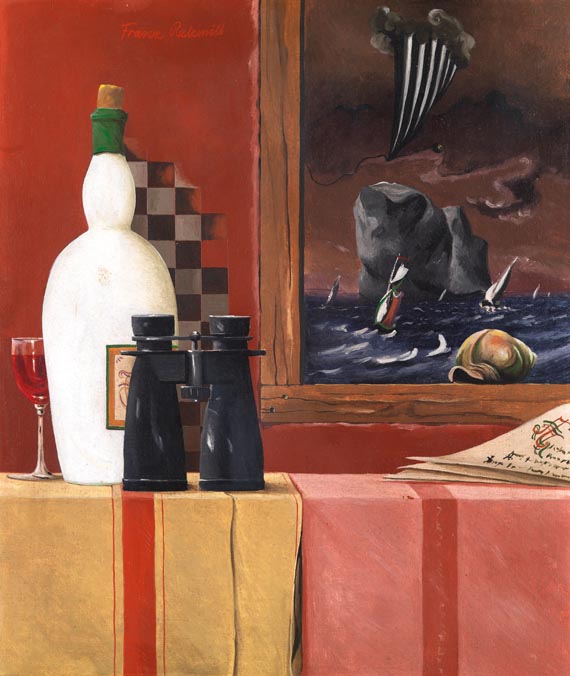
181
Franz Radziwill
Stillleben mit dem Fernglas, 1947.
Oil on canvas
Estimate:
€ 25,000 / $ 29,500 Sold:
€ 34,160 / $ 40,308 (incl. surcharge)
Oil on canvas mounted on wood
Firmenich/Schulze 590. Signed upper left. With work number "384" on rear. 53,5 x 45 cm (21 x 17,7 in)
Artist's list 4 no. 384.
PROVENANCE: Galerie Commeter, Hamburg, with gallery's label on rear
Private collection North Germany.
EXHIBITION: Franz Radziwill. Graphisches Kabinett Wolfgang Werner, Bremen 1948 no number
Franz Radziwill. Galerie Aloys Faust, Köln 1948 no number
Franz Radziwill. Verein der Kunstfreund, Kunsthalle Wilhelmshaven 1949 no number
Franz Radziwill, Bilder, Aquarelle, Zeichnungen. Museum Goslar 1952 no number
Franz Radziwill, 35 Gemälde, 17 Aquarelle, 6 Zeichnungen. Museum, Herford 1956 no number
Franz Radziwill, Arbeitsgruppe Kunst und Kunsthandwerk. Osterstegschule, Leer 1965, cat. no. 7
Franz Radziwill. Galerie Kohbrock & Vehring, Syke 1967 no number
Franz Radziwill, 128 Gemälde, 53 Aquarelle, 23 Blatt Graphik. Galerie Baukunst, Cologne 1968, cat. no.- 67
Franz Radziwill. Heimatmuseum, Varel 1968, no. 16
Franz Radziwill. Galerie Wendtorf & Swetec. Düsseldorf 1970 Nr. 33/Bürgerhaus, Gießen 1970, no. 18
Franz Radziwill, Gemälde, Aquarelle, Zeichnungen. Kunsthalle, Bremen 1970, no. 27/Kunstverein Hanover 1971, no. 27 with illu. p. 37.
Franz Radziwill was born as the first of seven children in Strohausen near Rodenkirchen on the Lower Weser in 1895. He studied architecture and also attended evening classes in figure drawing at the school of applied arts in Bremen until 1915. He was introduced to artist circles in Fischerhude and Worpswede by his teacher Karl Schwally, where Radziwill met Bernhard Hoetger, Otto Modersohn, Heinrich Vogeler and Clara Rilke-Westhoff. After returning from a British war captivity in 1919, Radziwill settled in Berlin for a couple of years where he joined the 'Free Secession' and the 'Novembergruppe'. He moved to Dangast on the North Sea in 1923, and had his first one-man exhibition in Oldenburg two years later, in 1925. In the same year, Radziwill increasingly abandoned the Expressionist style of his early work. He developed a friendship with Otto Dix in this year, who introduced him to artist circles of 'New Objectivity' and worked in the studio of Dix in Dresden until 1928. He participated in the large 'New Objectivity' exhibition in the Stedelijk Museum in Amsterdam in 1929. He was much praised when he took over Paul Klee's chair at the Düsseldorf academy in 1933. The Nazis forced him to resign two years later, however, and imposed an occupational ban on him. Having fought in a war for the second time from 1939 to 1945, he returned to his house in Dangast.
Der magische Realismus in den Bildern von Franz Radziwill teilt sich in den den Stillleben auf besondere Weise mit. Hier weitestgehend frei von narrativen Elementen sprechen Dinge ihre geheime Sprache. Es ist eine bedrückende Stille, die sich da mitteilt. Jedes Ding scheint seinen Stellenplatz für sich zu behaupten. Franz Radziwill suchte in seinen Stillleben nicht das schöne Arrangement ausgewählter Objekte. Er fixiert die Elemente seiner Kompositionen in einer Art seltsamer Erstarrung, von der eine verschlüsselte Botschaft ausgeht, die zu deuten, dem Betrachter überlassen wird.
The Oldenburg Kunstverein organized a large exhibition of Radziwill's work on occasion of his sixtieth birthday, which in the following toured sixteen German cities. The artist was awarded the Villa-Massimo Prize in 1963 and spent some time in Rome. Around the mid 1960s Radziwill began changing his older works by painting over them. The artist died in Varel-Dangast in 1983. [KD]
181
Franz Radziwill
Stillleben mit dem Fernglas, 1947.
Oil on canvas
Estimate:
€ 25,000 / $ 29,500 Sold:
€ 34,160 / $ 40,308 (incl. surcharge)
Headquarters
Joseph-Wild-Str. 18
81829 Munich
Phone: +49 89 55 244-0
Fax: +49 89 55 244-177
info@kettererkunst.de
Louisa von Saucken / Undine Schleifer
Holstenwall 5
20355 Hamburg
Phone: +49 40 37 49 61-0
Fax: +49 40 37 49 61-66
infohamburg@kettererkunst.de
Dr. Simone Wiechers / Nane Schlage
Fasanenstr. 70
10719 Berlin
Phone: +49 30 88 67 53-63
Fax: +49 30 88 67 56-43
infoberlin@kettererkunst.de
Cordula Lichtenberg
Gertrudenstraße 24-28
50667 Cologne
Phone: +49 221 510 908-15
infokoeln@kettererkunst.de
Hessen
Rhineland-Palatinate
Miriam Heß
Phone: +49 62 21 58 80-038
Fax: +49 62 21 58 80-595
infoheidelberg@kettererkunst.de
We will inform you in time.




 Lot 181
Lot 181 